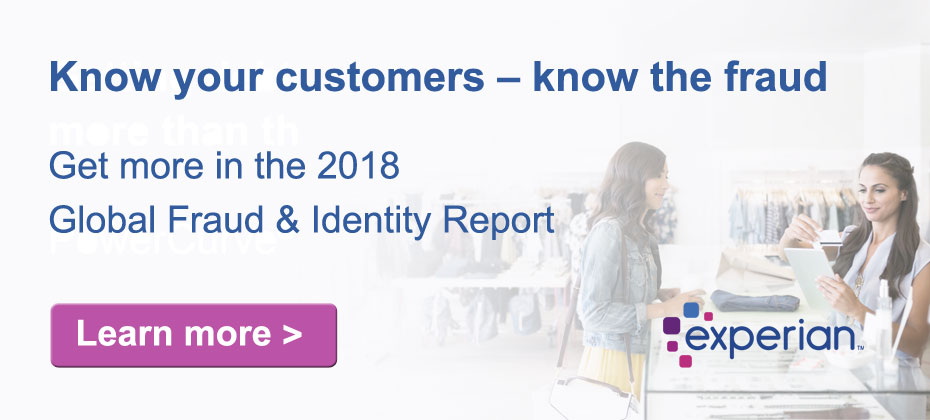Apply DA Tag

I recently sat down with Kathleen Peters, SVP and Head of Fraud and Identity, to discuss the state of fraud and identity, the pace of change in the space and her recent inclusion in the Top 100 influencers in Identity by One World Identity. ----------- Traci: Congratulations on being included on the Top 100 influencers list. What a nice honor. Kathleen: Yes, thank you. It is a nice honor and inspiring to be included among some great innovators in the industry. The list includes entrepreneurs to leaders of large organizations like us. It’s a nice mix across all facets of identity. T: Tell me about your role. How long have you been at Experian? K: I lead the team that defines the product strategy for our global fraud and ID portfolio. I’ve been with Experian just over four years, joining soon after we acquired 41st Parameter®. T: What was your first job? K: My first job out of college was with Motorola in Chicago. I was an electrical engineer, working on advanced cellphone technology. T: They were not able to keep up with the market? K: The entire industry was caught by the introduction of the iPhone. All the major cellphone companies were impacted — Nokia, Ericsson, Siemens and others. Talk about disrupting an industry. T: Yeah. These are great examples of how the disrupters have taken out the initial companies. Certainly, Motorola, Nokia, those companies. Even RIM Blackberry, which redefined the digital or cellular space, has all but disappeared. K: Yes, exactly. It was interesting to watch RIM Blackberry when they disrupted Motorola’s pager business. Motorola had a very robust pager line. Even then they had a two-way pager with a keyboard. They just missed the idea of mobile email completely. It’s really, really fascinating to look back now. T: Changing the subject a little, what motivates you to get out of bed in the morning? K: One of my favorite questions. I’m a very purpose-driven person. One of the things I really like about my role and one of the reasons I came to Experian in the first place is that I could see this huge potential within the company to combine offline and online identity information and transaction information to better recognize people and stop fraud. T: What do you see as the biggest threat to organizations today? K: I would have to say the pace of change. As we were just talking about, major industries can be disrupted seemingly overnight. We’re in the midst of a real digital transformation in how we live, how we work, how we share information and even how we share money. The threat to companies is twofold. One is the “friendly fire” threat, like the pace of change, disrupters to the market, new ways of doing things and keeping pace with that innovation. The second threat is that with digitization comes new types of security and fraud risks. Today, organizations need to be ever-vigilant about their security. T: How do you stay ahead of that pace of change? K: Well, my husband and I have lived in Silicon Valley since 1997. Technology and innovation are all around us. We read about it and we hear about it in the news. We engage with our neighbors and other people who we meet socially and within our networks. You can’t help but be immersed in it all the time. It certainly influences the way we go about our lives and how we think and act and engage as a family. We’re all technically curious. We have two kids, and our neighborhood high school, Homestead High, is the same high school Steve Jobs went to. It’s fun that way. T: Definitely. What are some of the most effective ways for businesses to combat the threat of fraud? K: I firmly believe that nowadays it all needs to start with identity. What we’ve found — and confirmed through research in our recent Global Fraud Report, plus conversations I’ve had with clients and analysts — is that if you can better recognize someone, you’ll go a long way to prevent fraud. And it does more than prevent fraud; it provides a better experience for the people you’re engaged with. Because once you recognize an individual, that initiates a trusted relationship between the two of you. Once people feel they’re in a trusted relationship, whether it’s a social relationship or a financial transaction, whatever the relationship is — once you feel trusted, you feel safe, you feel protected. And you’re more likely to want to engage again in the future. I believe the best thing organizations can do is take a multilayered approach to authenticating and identifying people upfront. There are so many ways to do this digitally without disrupting the consumer, and this is the best opportunity for businesses. If we collectively get that right, we’ll stop fraud. T: What are some of the things Experian is focusing on to help businesses stop fraud? K: We’ve focused on our CrossCore® platform. CrossCore is a common access and decisioning capability platform that allows the combining and layering of many different approaches — some active, some passive — to identify a customer in a transaction. You can incorporate things like biometrics and behavioral attributes. You can incorporate digital information about the device you’re engaging with. You can layer in online and offline identity information, like that from our Precise ID® product. CrossCore also enables you to layer in other digital attributes and alternative data such as email address, phone number and the validity of that phone number. CrossCore provides a great opportunity for us to showcase innovation, whether that comes from a third-party partner or even from our own Experian DataLabs. T: How significant do you see machine learning moving forward? K: Machine learning, it has all kinds of names, right? I think of machine learning, artificial intelligence, data robotics, parallel computing — all these things are related to what we used to call big data processing, but that’s not really the trendy term anymore. The point is that there is so much data today. There’s a wealth of data from all different sources, and as a society we’re producing it in exponential volumes. Having more and more and more data is not useful if you can’t derive insights from it. That’s why machine learning, augmented with human intervention or direction, is the best way forward, because there’s so much data out there available in the world now. No matter what problem we’re trying to solve, there’s a wealth of data we can amass, but we need to make sense of it. And the way to make sense of massive amounts of data in a reasonable amount of time is by using some sort of artificial intelligence, or machine learning. We’re going to see it in all kinds of applications. We already are today. So, while I think of machine learning as a generic term, I do think it’s going to be with us for a while to quickly compute and derive meaningful insights from the massive amounts of data all around us. T: Thanks, okay. Last question, and I hope a little fun. How would you describe yourself in one word? K: Curious. T: Ah, that’s a good choice. K: I am always curious. That’s why I love living where I live. It’s why I like working in technology. I’ve always wondered how things work, how we might improve on them, what’s under the hood. Why people make the decisions they do. How does someone come up with this? I’m always curious. T: Well, thank you for the time, and congrats again on being included in the Top 100 influencers in Identity.

The average number of retail trades per consumer has been trending down since 2007. But the average consumer retail debt is trending up, roughly $73 year-over-year. When analyzing single-store credit card debt by state in 2017, we found: States with the highest retail debt: Texas ($2,198) Alaska ($2,170) Arkansas ($2,067) States with the lowest amount of retail debt: Wisconsin ($1,374) Minnesota ($1,440) Hawaii ($1,442) Whether you’re a retailer, credit union or financial institution, stay ahead of the competition by using advanced analytics to target the right customers and increase profitability. More credit trends

Traditional credit attributes provide immense value for lenders when making decisions, but when used alone, they are limited to capturing credit behavior during a single moment of time. To add a deeper layer of insight, Experian® today unveiled new trended attributes, aimed at giving lenders a wider view into consumer credit behavior and patterns over time. Ultimately, this helps them expand into new risk segments and better tailor credit offers to meet consumer needs. An Experian analysis shows that custom models developed using Trended 3DTM attributes provide up to a 7 percent lift in predictive performance when compared with models developed using traditional attributes only. “While trended data has been shown to provide additional insight into a consumer’s credit behavior, lack of standardization across different providers has made it a challenge to gain those insights,” said Steve Platt, Experian’s Group President of Decision Analytics and Data Quality. “Trended 3D makes it easy for our clients to get value from trended data in a consistent manner, so they can make more informed decisions across the credit life cycle and, more importantly, give consumers better access to lending options.” Experian’s Trended 3D attributes help lenders unlock valuable insights hidden within credit reports. For example, two people may have similar balances, utilization and risk scores, but their paths to that point may be substantially different. The solution synthesizes a 24-month history of five key credit report fields — balance, credit limit or original loan amount, scheduled payment amount, actual payment amount and last payment date. Lenders can gain insight into: Changes in balances over time Migration patterns from one tradeline or multiple tradelines to another Variations in utilization and credit limits Changes in payment activity and collections Balance transfer and debt consolidation behavior Behavior patterns of revolving trades versus transactional trades Additionally, Trended 3D leverages machine learning techniques to evaluate behavioral data and recognize patterns that previously may have gone undetected. To learn more information about Experian’s Trended 3D attributes, click here.

Credit card balances grew to $786.6 billion at the end of 2017, a 6.7% increase to the previous year and the largest outstanding balance in over a decade. And while the delinquency rate increased slightly to 2.26%, it is significantly lower than the 4.73% delinquency rate in 2008 when outstanding balances were $737 billion. The increase in credit card balances combined with the slight growth in delinquencies points to a positive credit environment. Stay up to date on the latest credit trends to maximize your lending strategies and capitalize on areas of opportunity. Get more credit trends and insights at our webinar on March 8. Register here

Today’s consumer lending environment is more dynamic and competitive than ever, with renewed focus on personal loans, marketplace lending and the ever-challenging credit card market. One of the significant learnings from the economic crisis is how digging deeper into consumer credit data can help provide insights into trending behavior and not just point-in-time credit evaluation. For example, I’ve found consumer trending behavior to be very powerful when evaluating risks of credit card revolvers versus transactors. However, trended data can come with its own challenges when the data isn’t interpreted uniformly across multiple data sources. To address these challenges, Experian® has developed trended attributes, which can provide significant lift in the development of segmentation strategies and custom models. These Trended 3DTM attributes are used effectively across the life cycle to drive balance transfers, mitigate high-risk exposure and fine-tune strategies for customers near score cutoffs. One of the things I look for when exploring new trended data is the ability to further understand payment velocity. These characteristics go far beyond revolver and transactor flags, and into the details of consumer usage and trajectory. As illustrated in the chart, a consumer isn’t easily classified into one borrowing persona (revolver, transactor, etc.) or another — it’s a spectrum of use trends. Experian’s Trended 3D provides details needed to understand payment rates, slope of balance growth and even trends in delinquency. These trends provide strong lift across all decisioning strategies to improve your business performance. In recent engagements with lenders, new segmentation tools and data for the development of custom models is at the forefront of the conversation. Risk managers are looking for help leveraging new modeling techniques such as machine learning, but often have challenges moving from prior practices. In addition, attribute governance has been a key area of focus that is addressed with Trended 3D, as it was developed using machine learning techniques and is delivered with the necessary documentation for regulatory conformance. This provides an impressive foundation, allowing you to integrate the most advanced analytics into your credit decisioning. Alternative data isn’t the only source for new consumer insights. Looking at the traditional credit report can still provide so much insight; we simply need to take advantage of new techniques in analytics development. Trended attributes provide a high-definition lens that opens a world of opportunity.

Organizations that can mobilize their data assets to power critical business initiatives will see a distinct advantage in the coming years. In fact, most C-level executives (87%) believe data has greatly disrupted their organization’s operations over the past 12 months. Here are more insights from the newly released 2018 global data management benchmark report: As digital transformation efforts proliferate and become commonplace, organizations will need to implement processes and technology that scale with the demands of data-driven business. Read the full report

It’s clear the digital marketplace is here to stay. Online activities among consumers reflect the increased adoption of digital commerce. In fact, recent findings from our 2018 Global Fraud and Identity Report show the top activity on mobile devices is online shopping, followed closely by personal banking. Consumers trust technology and, by proxy, the businesses that help enable it. It’s critical for organizations to continue to build trust online without disrupting the consumer experience. It’s the goal — and the responsibility — of businesses. Learn more

Experian® is honored to be an MRC Technology Award nominee. But we can’t win the MRC People’s Choice Award without your help! The annual MRC Technology Awards recognize the most elite solution providers making significant contributions in the fraud, payments and risk industries. CrossCore® is the first smart, open, plug-and-play platform for fraud and identity services. We know, and our clients agree, that it delivers a better way to modify strategies quickly, catch fraud faster, improve compliance and enhance the customer experience. Need further convincing? Here are the top 3 reasons you should vote for CrossCore. Reason 1: common access Manage your entire fraud and identity portfolio. Start immediately by turning on Experian services through a single integration. Connect to services quickly with a common, flexible API. Reason 2: open approach Control the data being used in decisions. CrossCore supports a best-in-class approach to managing a portfolio of services that work together in any combination — including Experian solutions, third-party services and client systems — delivering the level of confidence needed for each transaction. Reason 3: workflow decisioning Act quickly and adapt to new risks with built-in strategy design and workflow capabilities. You can precisely tailor strategies based on transaction type or risk threshold. Make changes dynamically, with no downtime. We hope you’ll vote for CrossCore as a better way to manage fraud prevention and identity services.

Are you ready to launch a new product to capture the revenue growth opportunities in today’s market? The competition is heating up for new growth, as banks increased personal loan balances by 10 percent year-over-year in 2015 and another 6 percent in 2016.* Many lenders are now looking for robust data to understand the market opportunity based on their risk appetite. This challenge usually takes a significant investment in consumer credit data to gain the necessary insights. In helping lenders launch new products, I’ve found there are common areas of focus and specific steps you must take to move from the initial business case to more tactical planning. The following details come to mind: refining risk thresholds, pricing, loss forecasting and use of models within the initial go-to-market strategy. These project tasks can’t be successfully completed without having the right breadth and depth of data available. Knowing the past can help you create a better future for your business. When I start working with a client on a new product launch, I want to ensure they have sufficient data that can provide a comprehensive historical consumer view. In my experience, the best data to use will show an exhaustive view of consumer behaviors through the economic cycle. Having this large volume of data enables me to evaluate the business strategy and risks through the financial crisis while also giving my clients the foundation for compliance with loss forecasting regulations. Obtaining this breadth of data often can be a significant, but necessary, investment. Data is a great starting point, but it isn’t enough. Understanding the data sufficiently to design an effective go-to-market strategy is critical for success. I’ve found that identifying specific attributes helps give my clients a deep dive into the structure of a consumer’s credit history at the trade level. This level of information provides insight into the structure of the consumer’s wallet and preferences. Additionally, this depth of data allows my clients to develop powerful custom models for use in their business strategy. Being prepared is half the victory. Having comprehensive data that will help you understand consumer spending behavior and the risk they carry through the economic cycle will assist in creating a successful go-to-market strategy. Our Market Entry ServicesTM data sets are analytics-ready, including attributes and performance flags, to give you a holistic view of your target market. Having this breadth and depth of data, along with strong tactical planning and execution, will ensure your success in launching new products and entering new markets. *Experian–Oliver Wyman Market Intelligence Report

Our 8th annual State of Credit report shows that consumer credit scores and signs of economic recovery continue on an upward trend, coming close to a prerecession environment. The average U.S. credit score is up 2 points to 675 from last year and is just 4 points away from the 2007 average. Originations are increasing across nearly all loan types, with personal loans and automotive loans showing 11% and 6% increases year-over-year, respectively. Consumer confidence is up 25% year-over-year and has increased more than 16% from this period in 2007. With employment and consumer confidence rising, the economy is expected to expand at a healthy pace this year and continue to rebound from the recession. Now is the time to capitalize on this promising credit trend. State of Credit 2017

Global Fraud and Identity Report 2018 Customer recognition. Convenience. Trust. Fraud risk. We obtained input from more than 5,500 consumers and 500 businesses worldwide on these priorities for our Global Fraud and Identity Report 2018. Top takeaways include: Your customers expect you to protect them. Are you meeting this need? Spot fraud by recognizing your customers. Can you identify yours? While perfect fraud prevention shouldn't undermine customer happiness, we can't forget that fraud victims aren’t happy customers. Businesses recognize the importance of trust - and the need for technology to enable it. Most businesses tend to demonstrate suspicion when it comes to preventing fraud, following a route of detection rather than permission or trust. This leads to lost sales and damages that customer’s lifetime value. There’s a better approach. Read the full report>

Once a scorecard has been redeveloped, it is important to measure the impact of changes within the strategy by replacing the old model with the new one. This impact assessment can be completed with a swap set analysis. The term swap set refers to “swapping out” a set of bad accounts and replacing them with or “swapping in” a set of good accounts. Different approaches can be used when evaluating swap sets to optimize your strategy and keep: The same overall bad rate while increasing the approval rate. The same approval rate while lowering the bad rate. The same approval and bad rates but an increase in customer activation or customer response rates. When measuring your swap sets, remember to also include the population that doesn’t change — those accounts that would be approved or declined using either the old or new model. Learn more>

You’ve been tasked with developing a new model or enhancing an existing one, but the available data doesn’t include performance across the entire population of prospective customers. Sound familiar? A standard practice is to infer customer performance by using reject inference, but how can you improve your reject inference design? Reject inference is a technique used to classify the performance outcome of prospective customers within the declined or nonbooked population so this population’s performance reflects its performance had it been booked. A common method is to develop a parceling model using credit bureau attributes pulled at the time of application. This type of data, known as pre-diction data, can be used to predict the outcome of the customer prospect based on a data sample containing observations with known performance. Since the objective of a reject inference model is to classify, not necessarily predict, the outcome of the nonbooked population, data pulled at the end of the performance window can be used to develop the model, provided the accounts being classified are excluded from the attributes used to build the model. This type of data is known as post-diction data. Reject inference parceling models built using post-diction data generally have much higher model performance metrics, such as the KS statistic, also known as the Kolmogorov-Smirnov test, or the Gini coefficient, compared with reject inference parceling models built using pre-diction data. Use of post-diction data within a reject inference model design can boost the reliability of the nonbooked population performance classification. The additional lift in performance of the reject inference model can translate into improvements within the final model design. Post-diction credit bureau data can be easily obtained from Experian along with pre-diction data typically used for predictive model development. The Experian Decision Analytics team can help get you started.

The multitude of modern fraud strategies available today necessitates applying an appropriate level of confidence to increase the likelihood of catching fraudsters without disrupting legitimate customers’ experiences. This approach is known as “rightsizing” your fraud solution. Here’s how fraud detection rates can be improved while reducing the number of false positives and disruption of legitimate customers: A right-size approach means tackling your fraud problem with a highly tailored solution that enables your business rather than crippling it. Next week, we’ll discuss this forward-looking approach to fighting fraud, or you can jump ahead and read our latest tip sheet. Tip sheet>

You just finished redeveloping an existing scorecard, and now it’s time to replace the old with the new. If not properly planned, switching from one scorecard to another within a decisioning or scoring system can be disruptive. Once a scorecard has been redeveloped, it’s important to measure the impact of changes within the strategy as a result of replacing the old model with the new one. Evaluating such changes and modifying the strategy where needed will not only optimize strategy performance, but also maximize the full value of the newly redeveloped model. Such an impact assessment can be completed with a swap set analysis. The phrase swap set refers to “swapping out” a set of customer accounts — generally bad accounts — and replacing them with, or “swapping in,” a set of good customer accounts. Swap-ins are the customer population segment you didn’t previously approve under the old model but would approve with the new model. Swap-outs are the customer population segment you previously approved with the old model but wouldn’t approve with the new model. A worthy objective is to replace bad accounts with good accounts, thereby reducing the overall bad rate. However, different approaches can be used when evaluating swap sets to optimize your strategy and keep: The same overall bad rate while increasing the approval rate. The same approval rate while lowering the bad rate. The same approval and bad rate but increase the customer activation or customer response rates. It’s also important to assess the population that doesn’t change — the population that would be approved or declined using either the old or new model. The following chart highlights the three customer segments within a swap set analysis. With the incumbent model, the bad rate is 8.3%. With the new model, however, the bad rate is 4.9%. This is a reduction in the bad rate of 3.4 percentage points or a 41% improvement in the bad rate. This type of planning also is beneficial when replacing a generic model with another or a custom-developed model. Click here to learn more about how the Experian Decision Analytics team can help you manage the impacts of migrating from a legacy model to a newly developed model.